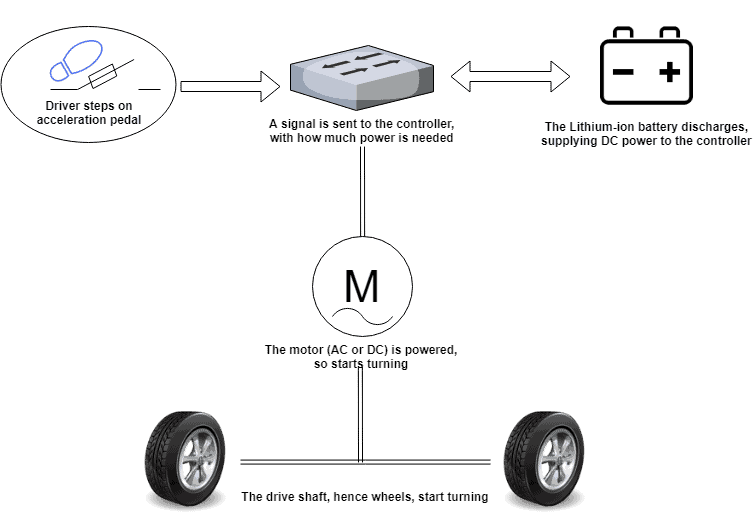The “vroom” sound that gasoline powered cars make when you put your foot down is familiar to us all, but despite electric cars becoming increasingly popular, the majority of the public have not yet driven one. So what are they like to drive?
Electric cars feel very responsive when accelerating and braking, whilst delivering a smoother experience than traditional cars. Their low centre of gravity helps when taking bends and turns, and they are very quiet even when quickly accelerating.
This article goes into more detail about what EVs are like to drive, along with some tips and ‘gotaches’ that you need to know when driving an electric car.
Driving An EV: What Is It Like?
Bosch arranged for 17 people who had never driven an electric car before to drive a Fiat 500e, Fiat’s only electric car and one which is fairly low power by modern electric car standards. You can see their views on the driving experience below:
Some interesting quotes from that video include:
- “You could really feel it [on turns]; it was great”
- “I press the pedal… and boom! It’s zippy and fun.”
- “I’ve never been in an electric car… this is real nice. “
- “I didn’t expect it to have so much power, it’s really responsive.”
- “It is… quiet. There’s not anything, other than the tires spinning.”
- “The handling is really nice too, because you make a turn and the centre of gravity is so low that it really helps it stick to the road.”
- “Everyone needs to have an electric vehicle; it’s great, I love it.”
This echos most people’s opinions after driving in an electric car, too. Because electric cars do not need to wait for fuel to be burned in a combustion engine before movement energy is generated, they can deliver ‘instant torque’: meaning that the moment you put your foot down, the EV will respond and accelerate accordingly (without the small delay which fossil-fuel cars have). This is covered in more detail in our ‘How exactly do electric cars work?’ article, but in essence all the parts of the drivetrain and powertrain are electric:

Due to this, an electric car will respond instantly when the driver puts their food down on the pedal. This is why many of the new-to-EV drivers from the video are surprised at how fast and responsive it is. Electric cars actually have less power available overall than a gasoline powered car (right now, although this will probably change throughout the 2020s), but the fact that any ‘reaction’ from the car is instant does lead to a nice overall driving experience.
The other noticeable thing when driving an electric car is how quiet and smooth it is. This is because there is no internal combustion engine with pistons forcing fuel into chambers to be frequently burnt and turned into movement energy (with any waste going through an exhaust)… and there is no exhaust either.
Two other things that people often remark is:
- There is no gear/transmission system in the traditional sense, because there is no need for it: electric cars are effective at all RPM ranges, unlike fossil-fuelled power cars (which have to try and manage inefficiencies at different RPM ranges, via gears).
- There is a lower center of gravity, which is especially noticeable on bends. This is because electric cars are powered by massive battery packs which weigh up to 540kg. This weight is distributed evenly over most of the middle part of the car, and some people like how this extra weight makes the car’s handling feel. (Of course, some people dislike it too!).
Range Anxiety (Charging Up)
One key difference between a fossil-fuel car and an electric car is that gasoline cars tend to have a range of 400-800 miles (643 – 1287 km), whereas most EVs on the road have a range below 200 miles (322 km). Whilst their range is starting to improve, the range of traditional cars is much higher on average than electric vehicles. Plus there are gasoline pumps everywhere, but electric charging stations are rarer (but again, this is also starting to improve).
The low range and lack of frequent charging stations (especially outside of city centres) means that range anxiety is an issue for many electric car owners. This refers to driving along, knowing that your destination is 80km away – but knowing that your car only has 90km of range left. Whilst this might sound fine, if you get hit by a diversion or traffic jam, your remaining range will start to creep down – causing you anxiety in that you will start to worry about about if you can get to your destination. Two pieces of advice we would give any electric car owner is:
- Make sure that if you are going on a long journey, you leave with a full battery and you know where any EVSE (charging stations) are along your route. This way you can be reasonably confident that you will reach your destination without issue, even if it means coming off to temporarily charging up along the way. Equally, be sure to check the EPA-rated range of any electric car you are looking to buy – whilst this is not always 100% accurate, there is currently a big range variation in the EV market so ensure that the car you are buying offers a range which suits your requirements.
- Whilst we recommend to leave with a 100% charged battery for long journeys, in general you should avoid charging beyond 80%. This helps to protect your battery because charging beyond 80% can start to stress your battery, pushing up temperatures and (in the long run) harming its overall capacity. Equally, batteries get stressed below 20% of charge. So wherever possible, aim to charge your car up when it hits 20-30% – and stop charging it when it hits around 80%. This will prolong your battery capacity more than frequently charging to 100%.
Whilst the thought of range anxiety might be off-putting at first, it quickly stops being a problem for electric car drivers because it all comes down to planning and ultimately knowing the real-world range of your EV. Plus the battery capacity (hence range) is due to increase a lot in the coming years, due to improvements in battery density and solid state batteries.
Driving Efficiently

It is worth driving your electric car slightly more gently than a traditional car: accelerate it fairly smoothly, and do not brake harshly. Especially do not accelerate quickly over a short distance and then slam on your brakes, since this is quite literally a waste of energy!
Electric cars also have ‘regenerative braking’, which is where the car will recover some (if not all) of the electrical power which was driving a car forward, when you need to slow down or stop. Different EVs implement regenerative braking in slightly different ways, so make sure you know how it works in your car because this will really help to improve the efficiency of your car.
Finally, how you heat and cool your car is important in an electric car because the more you use heating or air conditioning (which are powered by your battery), the less driving range you will have. Whilst this might sound obvious, much of the heat in as fossil-fuel car comes as a by-product of the engine (i.e. the engine’s heat is ‘recycled’ as heat inside the car) meaning that electric cars are less efficient than gasoline cars in this regard.
Watch Out For Nearby Pedestrians
Something which is crucial to mention when driving an electric car is that – as driver’s mentioned above – it is very quiet! The downside of this is that pedestrians might not hear your car when you are driving past, leading to a potential collision if they step into the road without looking. After all, pedestrians have been naturally conditioned over time to know that the familiar sound of a gas-guzzler, meaning they will not instinctively ‘hear’ your electric car due to its different (and quiet) noise.
As always, be alert when driving and if it looks like a pedestrian might step into the road, slow down and/or beep your horn. Thankfully some electric cars emit a fake ‘pedestrian warning’ noise at low speeds, which will help to minimize the risk of pedestrians not hearing your car.